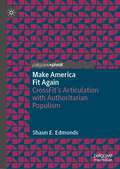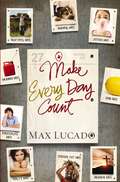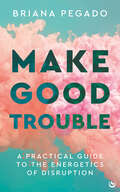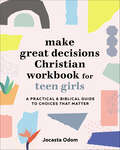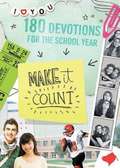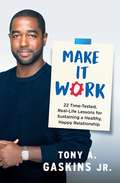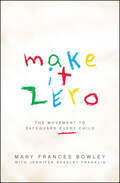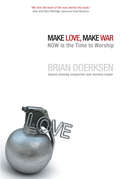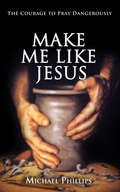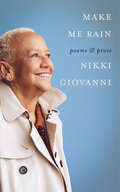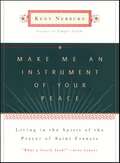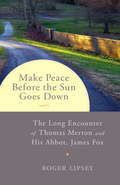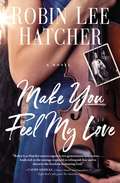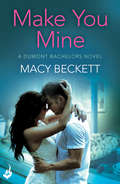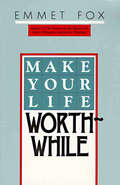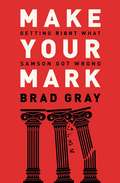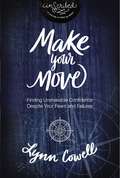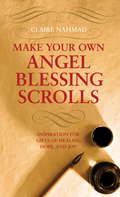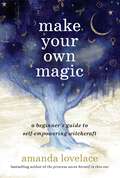- Table View
- List View
Make America Fit Again: CrossFit’s Articulation with Authoritarian Populism
by Shaun E. EdmondsThis book critically examines the CrossFit phenomenon and makes the argument that CrossFit uses the rhetoric and tactics found in modern forms of authoritarian populism to rally adherents around its brand. CrossFit is a private branded fitness organization whose unorthodox methods and adversarial leadership has challenged dominant ideas around health and fitness worldwide. In exploring CrossFit’s articulations with healthism and the obesity epidemic, the risk discourse of the prepper and survivalist movements, and the increasing valorization of the military and military personnel, Shaun E. Edmonds makes legible the ideological underpinnings of the CrossFit practice. After a deeper look at how CrossFit’s variation of authoritarian populism has been used to counter critics and mobilize the community, the book concludes by considering what might be next for CrossFit following former CEO and co-founder Greg Glassman’s controversial departure from the company.
Make Every Day Count - Teen Edition
by Max LucadoTeens really do want to make a difference, but sometimes their attitudes get in the way!Today's teens are faced with some big issues, and their attitudes can sometimes create even more struggles for their own lives and those around them. But best-selling author Max Lucado wants to teach teens that life is a gift and that gratitude is critical. With a little perspective, teens will see that God can help them overcome their ungrateful days, their stressed-out days, and even their catastrophic days. Life is not going to be perfect. When teens understand that and realize that God is their constant source of support, help, and blessings, even the difficult days can be faced with a cheerful spirit. Make Every Day Count shows readers how to deal with each day--no matter what it throws at them. Real-life teen stories, biblical accounts, and inspiring "Daylifters" encourage teens to make each day count for God.A study guide at the back of the book makes this a perfect choice for individual or group study.
Make Good Trouble: A Practical Guide to the Energetics of Disruption
by Briana PegadoThis is a galvanizing guide to making your life and community better with a life-changing new outlook on how change happens.This is a practical guide for anyone who wants to harness the energetics of disruption to catalyse change in their own lives and in society as a whole. Using various energy workings, including Theta Healing, tarot, astrology, goddess energy and so much more, this book will show the reader how to find their values, stand in their integrity, be a leader, and channel disruption for powerful change.Learn how disruption of the status quo releases energy, what that energy can do, and how you can begin to create itDiscover many practical ways of bringing about change, from the smallest steps of improving personal relationships, to whistleblowing and challenging big systems of powerDelve into the energy of goddesses and warrior queens as a tool to embody power and become a leader of change.Navigate by the archetypes of the Tarot and astrology to better understand your own journey as an individual standing in your integrity.Explore the Values Compass tool to unearth your true values and prioritiesUse the disruption toolkit to understand when to speak up, when to be silent and when to act.Equip yourself with the self-care tools to protect your own energy, including setting boundaries, building a network and rest as resistance.In the aftermath of disruption, understand how to restructure and rebuild for a better future.This book is for anyone who feels compelled to make the world a better place, anyone who is looking to bring compassion and equality to all aspects of their lives, including at work, at home, in friendships, in relationships, and most importantly in our relationship to ourselves.
Make Great Decisions Christian Workbook for Teen Girls: A Practical & Biblical Guide to Choices that Matter
by Jocasta OdomGive a teen the scriptural guidance and support she needs to make good choicesBecoming a teenager is an incredible time in a girl's life—one filled with change, possibility, and lots of new decisions. The Make Great Decisions Workbook for Christian Teen Girls will help your teen make choices she'll be proud of by providing her with a place to reflect and communicate with God every day.What makes the Make Great Decisions Workbook for Christian Teen Girls stand out from other devotionals for women and teen girl books:Daily devotionals for great decisions—Teens face numerous choices every day, like whether they'll check social media, or how long they'll study for a biology test. These inspirational Bible quotes will empower and inspire them to make sound decisions about school, friends, family, romance, and more.Faith-driven prompts—They'll complete exercises like writing a personal prayer they can call on whenever they need it, setting short- and long-term goals, and thinking about who their true friends are and why.A place to get creative—This book provides ample space to doodle, sketch, and color as they explore their thoughts and feelings because sometimes, spiritual growth is expressed beyond words.Help the teen girl in your life grow into the extraordinary young woman God created her to be with the Make Great Decisions Workbook for Christian Teen Girls.
Make It Count: 180 Devotions for the School Year
by Sue ChristianDuring a school year, a student’s calendar is filled with term papers, homework, football games, play rehearsals, band concerts, and so much more. It’s easy to get caught up in all the activity and forget to take a deep breath. Make it Count: 180 Devotions for the School Year is a unique devotional that provides students with encouragement for each day, as they count down the 180 days until the end of their school year. Each devotion features a short inspirational thought or quotation, as well as a brief prayer that will help students focus on their daily faith walk.
Make It Home Before Dark: God's Call To Holiness In Our Walk With Him
by Crawford W. Loritts, Jr.God calls us to live lives of holiness. But that is impossible without a close walk with Christ. That walk must begin with repentance; it is crucial to living biblical, practical holiness everyday. Crawford Loritts takes a fresh look at the role of repentance in Make It Home Before Dark. Written with warmth and insight, Loritts gives help to those struggling with sin or rejection in their lives. This is an honest and hopeful book, full of biblical insight and practical advice. It may be just the tool to help you in your journey to a fuller life in Christ.
Make It Home Before Dark: God's Call To Holiness In Our Walk With Him
by Crawford W. Loritts, Jr.God calls us to live lives of holiness. But that is impossible without a close walk with Christ. That walk must begin with repentance; it is crucial to living biblical, practical holiness everyday. Crawford Loritts takes a fresh look at the role of repentance in Make It Home Before Dark. Written with warmth and insight, Loritts gives help to those struggling with sin or rejection in their lives. This is an honest and hopeful book, full of biblical insight and practical advice. It may be just the tool to help you in your journey to a fuller life in Christ.
Make It Work: 22 Time-Tested, Real-Life Lessons for Sustaining a Healthy, Happy Relationship (History of Computing)
by Tony A. Gaskins Jr.Proven principles—drawn from real life failures and successes—for building and sustaining a loving, healthy relationship in today’s trying times, from celebrity life coach and motivational speaker, Tony Gaskins Jr. After speaking out about how weak and insecure men control women in relationships in 2009 on several globally televised shows, Tony Gaskins launched his career as a life coach and relationship counselor. Since then, Gaskins, who has been a faithful and committed husband for over a decade, has counseled thousands and inspired millions online, becoming one of America’s foremost experts on love and relationships. Practical and accessible, and delivered in the empowering, empathetic tone his devoted following has come to love and trust, Make It Work walks you through a series of essential lessons on how to maintain a healthy and long-lasting relationship. Drawing inspiration from the Bible and from his own personal failures and successes, Gaskins offers a framework for how to recognize the right person to settle down with, how to set standards that promote loving relationships—and what to avoid in a successful union. Make It Work arrives as a hopeful response to a culture where breakups and divorces are all too common, and it serves as a vital resource to help your relationship thrive today.
Make It Zero: The Movement to Safeguard Every Child
by Mary Frances Bowley"When we correct the factors that keep children at risk, we can make a difference in the lives of those children and the adults they&’ll grow up to be."— Mary Frances BowleyChildren are meant to imagine bright futures and chase them. But for the millions of at-risk children in America, hope is lost in the heavy fog of trauma. Make It Zero is a call to bring it back.Tying shocking statistics to real stories, Make It Zero explores various forms of childhood vulnerability and offers specific ways for everyone to end them. It reveals the world of opportunity behind a single moment of compassion, and it teaches us that when we help the hopeless dream again, we ourselves come more alive.A book for everyone—moms, dads, teachers, bus drivers, nurses, whomever—it calls us to fulfill our responsibility to children and build a world that is safe for every last one. Each of us is only one person, but one person determined to act is powerful. Moments can multiply into movements and create groundswells of change. Make It Zero is your moment. Be inspired. Be empowered. Help bring hope to every child.
Make It Zero: The Movement to Safeguard Every Child
by Mary Frances Bowley"When we correct the factors that keep children at risk, we can make a difference in the lives of those children and the adults they&’ll grow up to be."— Mary Frances BowleyChildren are meant to imagine bright futures and chase them. But for the millions of at-risk children in America, hope is lost in the heavy fog of trauma. Make It Zero is a call to bring it back.Tying shocking statistics to real stories, Make It Zero explores various forms of childhood vulnerability and offers specific ways for everyone to end them. It reveals the world of opportunity behind a single moment of compassion, and it teaches us that when we help the hopeless dream again, we ourselves come more alive.A book for everyone—moms, dads, teachers, bus drivers, nurses, whomever—it calls us to fulfill our responsibility to children and build a world that is safe for every last one. Each of us is only one person, but one person determined to act is powerful. Moments can multiply into movements and create groundswells of change. Make It Zero is your moment. Be inspired. Be empowered. Help bring hope to every child.
Make Love, Make War
by Brian DoerksenWorship elevates us into God's presence, renews our spirits, and expresses our deepest love for our Savior. Yet worship can also be a call to arms, a battle cry, a salvo in an ancient spiritual struggle.Acclaimed songwriter Brian Doerksen believes that God is calling us to both love and to battle. To spread peace and wage spiritual warfare. We do this through how we live, how we serve Him, and how we protect and fight for what matters most. For Brian, music was his answer to this provocative call.Now Brian shares the stories and inspirations behind some of today's most acclaimed songs of worship, including "Come, Now is the Time to Worship," "Hallelujah (Your Love is Amazing)," and "With All My Affection." Brian shares rich truths and insights that informed twelve of his greatest songs, and offers special tips for aspiring songwriters. Readers will be encouraged to wage spiritual war and share His love through a life of radical worship.
Make Me Like Jesus: The Courage to Pray Dangerously
by Michael PhillipsThe bestselling author serves up &“a marvelous, full-bodied repast for those Christians who seek God&’s presence rather than any blessings he might bestow&” (Publishers Weekly). Most of us want to know God more intimately. But are we willing to boldly face the challenge of what that means? Are we truly willing to pray a prayer that may be dangerous in ways we cannot anticipate? Are we willing to ask God to make us like Jesus? Author Michael Phillips shares from his own life how he has learned to take up that challenge. Then he examines key decisions in the life of Jesus Christ that illuminate what it means for each one of us to be conformed to the image of his son—to love like Jesus, think like him, pray like him, and trust the Father like him. If status-quo spirituality is for you, do not read this book. It is a dangerous book—dangerous to the flesh—for the journey toward Christlikeness may be painful and costly. Yet that journey leads to the ultimate purpose God intends for all his children: conformity to the image of his son. &“This book is a gem, written from the heart by a man I have called brother and friend for twenty years. Make Me Like Jesus gives us an open, honest look at what it really means to walk truthfully with Christ.&” —Jim Ryun, former Congressman, Olympian, and coauthor of Heroes Among Us &“Phillips offers a much-needed corrective to several popular but superficial descriptions of the Christian life.&” —Bishop William C. Frey, author of The Dance of Hope
Make Me Rain: Poems & Prose
by Nikki GiovanniOne of America’s most celebrated poets challenges us with this powerful and deeply personal collection of verse that speaks to the injustices of society while illuminating the depths of her own heart.For more than thirty years, Nikki Giovanni’s poetry has inspired, enlightened, and dazzled readers. As sharp and outspoken as ever, this artist long hailed as a healer and a sage returns with this profound book of poetry in which she continues to call attention to injustice and give readers an unfiltered look into the most private parts of herself.In Make Me Rain, she celebrates her loved ones and unapologetically declares her pride in her black heritage, while exploring the enduring impact of the twin sins of racism and white nationalism. Giovanni reaffirms her place as a uniquely vibrant and relevant American voice with poems such as “I Come from Athletes” and “Rainy Days”—calling out segregation and Donald Trump; as well as “Unloved (for Aunt Cleota)” and “”When I Could No Longer”—her personal elegy for the relatives who saved her from an abusive home life. Stirring, provocative, and resonant, the poems in Make Me Rain pierce the heart and nourish the soul.
Make Me an Instrument of Your Peace: Living in the Spirit of the Prayer of St. Francis
by Kent NerburnKent Nerburn's Make Me an Instrument of Your Peace, immerses us in the spirit of one of the most universally inspiring figures in history: St. Francis of Assisi. The Prayer of St. Francis boldly but gently challenges us to resist the forces of evil and negativity with the spirit of goodwill and generosity. And Nerburn shows, in his wonderfully personal and humble way, how we each can live out the prayer's prescription for living in our everyday and less-than-saintly lives. "Where there is hatred, let me sow love...Where there is injury, let me sow pardon..." Expanding upon each line of the St. Francis Prayer, Nerburn shares touching, inspiring stories from his own experience and that of others and reveals how each of us can make a difference for good in ordinary ways without being heroes or saints. Struggling to help a young son comfort his best friend when his mother dies, moved by the courage of war enemies who reconcile, being wrenched out of self-absorbed depression by responding to someone else's tragedy, taking a spirited old lady on a farewell taxi ride through her town-these are the kinds of everyday moments in which Nerburn finds we can live out the spirit of St. Francis. By incorporating the power and grace of these few lines of practical idealism into our thoughts and deeds, we can begin to ease our own suffering-and the suffering of those with whom we share our lives. And, remarkably, find a way to true peace and happiness by tapping into our basic human goodness. As we open our hearts and embrace his words, St. Francis "touches our deepest humanity and ignites the spark of our divinity." Lord, make me an instrument of thy peace.Where there is hatred let me sow love,Where there is injury let me sow pardon,Where there is doubt, faith,Where there is despair, hope,Where there is darkness, light,And where there is sadness, joy...In this beautifully written book, Kent Nerburn leads us into the heart of the St. Francis Prayer and line by line demonstrates how St. Francis's words can resonate in our lives today.
Make Peace before the Sun Goes Down: The Long Encounter of Thomas Merton and His Abbot, James Fox
by Roger LipseyIn the 1950s and '60s, Thomas Merton, a monk of the Trappist monastery of Gethsemani in Kentucky, published a string of books that are among the most influential spiritual books of the twentieth century--including the mega-best seller The Seven-Storey Mountain. He was something of a rock star for a cloistered monk, and from his monastic cell he enjoyed a wide and lively correspondence with people from the worlds of religion, literature, and politics. During that period he also explored and wrote extensively on Buddhism, Sufism, art, and social action. The man to whom he owed obedience in the cloistered life was a much more traditional Catholic, his abbot, Dom James Fox. To say that these two men had a conflicted relationship would be an understatement, but the tension their differences in orientation brought actually led to creative results on both sides and to a kind of hard-won respect and love. Roger Lipsey's portrait of this unusual relationship is compelling and moving; it shows Merton in the years his imagination was taking him far beyond the walls of the monastery, and eventually, literally to Asia.
Make Time for Yourself: It's Your Time
by Notker WolfThe book Make Time for Yourself It's Your Time is a text written from a very personal standpoint, in the context of the author's spiritual life as a monk. Nothing in this world has eternal value. Use your time and don't waste it. Time is for most of us a luxury good. Making time for yourself and giving time to others is a source of joy that enriches our lives. The quiet time we devote to prayer or meditation gives us strength to master our lives and enhances our spirituality.
Make You Feel My Love
by Robin Lee HatcherOne broken woman. One lost man. And the long-buried secrets tying them together.After escaping an abusive relationship, Chelsea Spencer flees to Chickadee Creek—the town where her great aunt Rosemary owns a quaint little antique shop. There, Chelsea plans to help with the shop as her aunt heals from an accident—and perhaps find some healing of her own.Liam Chandler was one film away from a leading role when his brother Jacob was stricken with cancer. After spending the last months of Jacob&’s life with him in Boise, Liam heads to the vacation home he built outside of Chickadee Creek to get his life and his faith back on track.While working to clean out a storage room in the antique shop, Chelsea finds an old violin. Aunt Rosemary says she may have the instrument, but they soon learn it is very valuable and once belonged to Cora Chandler, Liam&’s great-great-grandmother.Drawn together by the old violin and stories from the past, Chelsea and Liam begin to find answers for their present and the future God has in store for them.
Make You Mine: Dumont Bachelors 1 (Dumont Bachelors #2)
by Macy BeckettWelcome to the Louisiana Bayou and the world of Macy Beckett's series, where hopeful hearts will go to great lengths to change their luck in love... Fans of Jill Shalvis, Carly Phillips and Rachel Gibson will love Macy's sexy heat and humour!For ninety-nine years, every man in the Dumont family has remained a perpetual bachelor. Residents of Cedar Bayou, Louisiana, whisper about a voodoo hex cast upon the family, sabotaging each man's chance at marriage. In truth, the Dumont men have their own player personalities to blame, and Marc is no exception. As captain of his family's riverboat, he's broken hearts up and down the Mississippi. That is, until his high school crush strolls onboard... Allie Mauvais rocks the boat when she fills in as his pastry chef. She hasn't seen Marc since senior year, when rumors flew that her great-great-grandmother was the one who cursed the Dumonts. After two weeks on the water, neither can deny the attraction that still burns between them. But to truly reach Marc's heart, Allie must show him that the hex is all in his head and it'll take more than her mouthwatering sweets to prove it. Will Allie's love be enough to finally make Marc hers?Don't miss more from the spellbinding Dumont Bachelors in Make You Blush and Make You Remember.
Make You Remember: Dumont Bachelors 2 (Dumont Bachelors #3)
by Macy BeckettWelcome to the Louisiana Bayou and the world of Macy Beckett's series, where hopeful hearts will go to great lengths to change their luck in love... Fans of Jill Shalvis, Carly Phillips and Rachel Gibson will love Macy's sexy heat and humour!Ten years ago, Beau Dumont made the biggest mistake of his life by letting his high school sweetheart, Devyn Mauvais slip through his fingers. Now the reformed bad boy will stop at nothing to get her back. Even if it means tricking her into taking a job on his family's riverboat, The Belle of the Bayou.When Devyn's old flame offers her a stint at the boat's day care center, she sees it as a chance to prove she isn't just the descendant of Louisiana's most infamous voodoo queen. Besides, it beats leading ghost tours around New Orleans. Yet when it comes to Beau, Devyn's all business. She won't give the sweet-talking playboy another chance to break her heart.But there's no escaping temptation in such close quarters, and Beau won't be satisfied with a few hot nights with the girl he's always loved. As he strives to make Devyn remember the good times, will his passion and heart be enough to regain her trust? Don't miss more from the spellbinding Dumont Bachelors in Make You Blush and Make You Mine.
Make Your Life Worthwhile
by Emmet FoxHere are brief, pointed, practical instructions in successful living to help achieve real health, happiness, prosperity, greater security, andpeace of mind. In clear, concise terms, Emmet Fox outlines the sevenmental laws that are the stepping stones to full realization of the inner, spiritual Power which ties within the reach of anyone who sincerely wants it and who is willing to apply the principles set forth. Make Your Life Worthwhile reveals how you can put these principles to immediate use to begin transforming your life.Dr. Fox explains the eleven key words in the Bible and discusses what the Bible has to say about successful living, showing how its wisdom can become a part of your everyday life.This is a lifetime plan for tapping into the great spiritual truths that underlie, everyday existence and applying them to: Reach through to true spiritual Power * Use your own inner resources more fully * Overcome difficulties * Become a dynamic person * Achieve what you really desire * Pray unselfishly * Get results with positive thinking * Make the most of the present moment * Enhance spiritual growth and material well-being * Build confidence in yourself * Understand your unique role in God's unfolding purpose * and much more.
Make Your Life Worthwhile
by Emmet FoxHere are brief, pointed, practical instructions in successful living to help achieve real health, happiness, prosperity, greater security, andpeace of mind. In clear, concise terms, Emmet Fox outlines the sevenmental laws that are the stepping stones to full realization of the inner, spiritual Power which ties within the reach of anyone who sincerely wants it and who is willing to apply the principles set forth. Make Your Life Worthwhile reveals how you can put these principles to immediate use to begin transforming your life.Dr. Fox explains the eleven key words in the Bible and discusses what the Bible has to say about successful living, showing how its wisdom can become a part of your everyday life.This is a lifetime plan for tapping into the great spiritual truths that underlie, everyday existence and applying them to: Reach through to true spiritual Power * Use your own inner resources more fully * Overcome difficulties * Become a dynamic person * Achieve what you really desire * Pray unselfishly * Get results with positive thinking * Make the most of the present moment * Enhance spiritual growth and material well-being * Build confidence in yourself * Understand your unique role in God's unfolding purpose * and much more.
Make Your Mark: Getting Right What Samson Got Wrong
by Brad GrayWrestling with our calling in life is a fundamental struggle for just about everyone. Who are we supposed to be? How are we supposed to live? What are we supposed to do? These are all questions many of us grapple with. Surprisingly, the Samson narrative is one of the most instructive stories for helping us answer these questions. Often touted as a story about muscles, testosterone, and seduction, there is so much more to this ancient account. Employing all the best tools for interpreting the Bible today, Brad Gray unpacks the Samson story anew, giving us fresh insights into the universal callings of those desiring to live out God's fullest design for life. With passion, humor, and skill, Brad shows us how we can get right what Samson got wrong in order to flourish in our humanity, to make the most of the lives we've been given, and to leave a positive mark on our world.
Make Your Move: Finding Unshakable Confidence Despite Your Fears and Failures (InScribed Collection)
by Lynn CowellIn this six-session Bible study (DVD/digital video sold separately), author and Proverbs 31 Ministries speaker Lynn Cowell explores how confidence-in-question keeps us from boldly experiencing what God intends for our lives. Dive into six stories in the Bible of not-so-well-known women who found themselves needing confidence to make their move, and how they uncovered the faith to get it. Lynn encourages women to leave behind all the unnecessary insecurity this world induces and find confidence in God alone.Learn from the Daughters of Zelophehad, the Women of Exodus, Martha & Mary, Rahab, Deborah, Abigail and Michal how to:Intentionally build your confidence on the one thing that cannot be taken from you.Recover from defeating decisions to move forward toward a strong self-worth.Position yourself to not lose your poise—even in the worst circumstances.Identify and address the fears that keep you stuck, with practical steps to walk in your calling with confidence.This study is for any woman who’s ready to dig into God’s Word to find confidence and boldness to do great things. This book includes personal Bible study as well as group discussion questions. The study can be completed by individuals as well as in groups.Designed for use with the companion Make Your Move Video Study (sold separately).
Make Your Own Angel Blessing Scrolls
by Claire NahmadFirst used by the ancient Celts, angel scrolls were inscribed with runes or prayers that helped connect the physical world to the spirit realm. Make Your Own Angel Blessing Scrolls presents a wealth of projects that deliver angelic protection, healing, and blessings. Complete with beautiful photographs and simple instructions, this practical guide suggests sympathetic wording, describes how to invoke the blessing of the appropriate angel, and provides advice on infusing the scrolls with aromatic oils or herbs, and embellishing them with crystals and calligraphy. Display them for all to admire, and create a powerful conduit for angelic benefaction.
Make Your Own Magic
by Amanda LovelaceFrom the bestselling author of the princess saves herself in this one comes an accessible guide to welcoming magic into your life, perfect for beginner witches and the magic-curious alike.As witchcraft grows ever more popular, there are countless introductions and paths into magical practice to choose from - so many that you might not know where to begin. When you're just getting started, it's easy to be intimidated or discouraged or to feel that there's no place for you in the craft.With make your own magic, amanda lovelace aims to change that. This inviting beginner's guide shows that magic doesn't have to be fancy, time-consuming, or one-size-fits-all. It introduces the tenets of witchcraft so that you can develop your own practice and relationship with magic in whatever way works for you. With simple explanations, twenty all-new inspiring poems, words of encouragement, magical journaling prompts, and more, this book sweeps away the gatekeeping and offers you the tools needed to begin building a strong, long-lasting practice focused on self-love.
